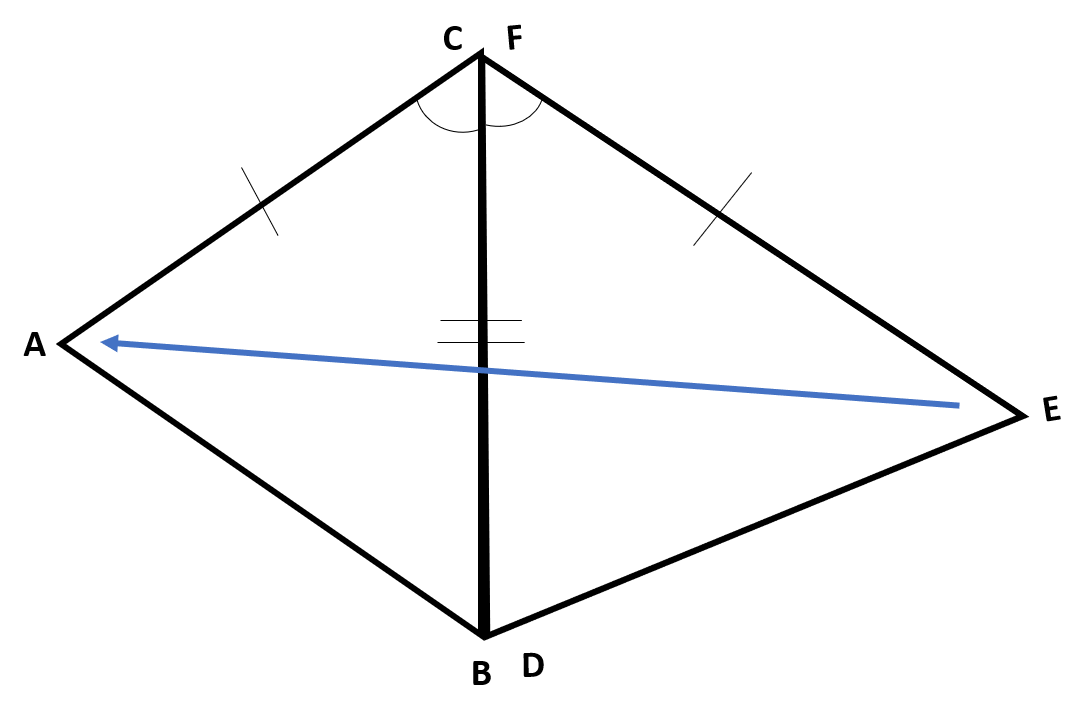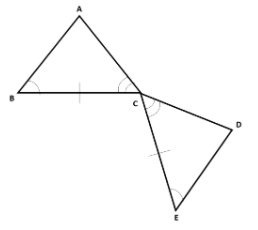Explain how the criteria for triangle congruence (ASA, SAS, and SSS) follow from the definition of congruence in terms of rigid motions. - Common Core: High School - Geometry
Card 0 of 10
What is rigid motion?
What is rigid motion?
Rigid motion follows these criteria because the motion is rigid meaning that everything that is moving stays the same except for the location of the entire figure. There are three common types of rigid motion; translation, reflection, and rotation.
Rigid motion follows these criteria because the motion is rigid meaning that everything that is moving stays the same except for the location of the entire figure. There are three common types of rigid motion; translation, reflection, and rotation.
Compare your answer with the correct one above
In terms of rigid motion, how do we know when two figures are congruent to one another?
In terms of rigid motion, how do we know when two figures are congruent to one another?
This is the correct definition in terms of rigid motions. Some of the other options are correct definitions for congruence but do not mention the criteria of there being rigid motion between the two figures. An example of this is that  and
and  are congruent because they are a reflection of one another. Their vertices that map to each other are
are congruent because they are a reflection of one another. Their vertices that map to each other are




This is the correct definition in terms of rigid motions. Some of the other options are correct definitions for congruence but do not mention the criteria of there being rigid motion between the two figures. An example of this is that 

Compare your answer with the correct one above
True or False: The following triangles are congruent by two different methods:

True or False: The following triangles are congruent by two different methods:

Let’s first begin by showing that these two triangles are congruent through a series of rigid motions. Let’s use our point of reference be  and
and  since we know that these angles are congruent through the information given in the picture. We are able to map
since we know that these angles are congruent through the information given in the picture. We are able to map  to
to  by reflecting
by reflecting  along the line
along the line  . So these two triangles are congruent.
. So these two triangles are congruent.
Now we will show that these two triangles are congruent through another theorem. We see that there are two pairs of corresponding congruent angles,  , and the angles’ included sides are congruent as well,
, and the angles’ included sides are congruent as well,  . The ASA Theorem states that if two triangles share two pairs of corresponding congruent angles and their included sides are congruent, then these two triangles are congruent. So by ASA, these triangles are congruent.
. The ASA Theorem states that if two triangles share two pairs of corresponding congruent angles and their included sides are congruent, then these two triangles are congruent. So by ASA, these triangles are congruent.
Let’s first begin by showing that these two triangles are congruent through a series of rigid motions. Let’s use our point of reference be 





Now we will show that these two triangles are congruent through another theorem. We see that there are two pairs of corresponding congruent angles, 

Compare your answer with the correct one above
The following two triangles are congruent by the SAS Theorem. What are the series of rigid motions that map them to one another? (Figures not to scale)

The following two triangles are congruent by the SAS Theorem. What are the series of rigid motions that map them to one another? (Figures not to scale)
First, we need to establish a vector that maps at least one pair of vertices. We will use  to establish a translation between the two figures. This also maps
to establish a translation between the two figures. This also maps  to
to  .
.


Now they share a vertex and we are able to rotate them together mapping  to
to  and
and  to
to  .
.


Now we can reflect across  mapping
mapping  to
to  ,
,  to
to  , and
, and  to
to  .
.


So the order of the series of rigid motions is translation, rotation, reflection.
First, we need to establish a vector that maps at least one pair of vertices. We will use 


Now they share a vertex and we are able to rotate them together mapping 



Now we can reflect across 






So the order of the series of rigid motions is translation, rotation, reflection.
Compare your answer with the correct one above
The following two triangles are congruent by the ASA Theorem. What are the series of rigid motions that map them to one another?

The following two triangles are congruent by the ASA Theorem. What are the series of rigid motions that map them to one another?

First, the two triangles  and
and  share a vertex, so we know that
share a vertex, so we know that  maps to
maps to  by the reflective property. Knowing this, we are able to rotate
by the reflective property. Knowing this, we are able to rotate  to match the congruent sides
to match the congruent sides  and
and  . This maps
. This maps  to
to  . We can also note that
. We can also note that  maps to
maps to  .
.

Now we can reflect the triangle  across
across  to map
to map  to
to  ,
,  to
to  and
and  to
to  .
.

So the order of rigid motions is rotation, reflection.
First, the two triangles 











Now we can reflect the triangle 








So the order of rigid motions is rotation, reflection.
Compare your answer with the correct one above
Give an informal proof that proves the following two triangles are congruent by the SAS Theorem and by a series of rigid motions.

Give an informal proof that proves the following two triangles are congruent by the SAS Theorem and by a series of rigid motions.

The SAS Theorem states that if two triangles share two pairs of corresponding congruent sides are congruent and their included angle is also congruent, then these two triangles are congruent. We are given that  and so these two triangles are congruent by the SAS theorem. We are able to map
and so these two triangles are congruent by the SAS theorem. We are able to map  to
to  by rotating
by rotating  180 degrees clockwise. So these two triangles are congruent by rigid motion.
180 degrees clockwise. So these two triangles are congruent by rigid motion.
The SAS Theorem states that if two triangles share two pairs of corresponding congruent sides are congruent and their included angle is also congruent, then these two triangles are congruent. We are given that 



Compare your answer with the correct one above
True or False: If two triangles are congruent through SAS Theorem and share a vertex, they will follow the rigid motions of rotation and reflection.
True or False: If two triangles are congruent through SAS Theorem and share a vertex, they will follow the rigid motions of rotation and reflection.
Consider the triangles  and
and  , where
, where  . We are able to rotate them together mapping
. We are able to rotate them together mapping  to
to  and
and  to
to  .
.


Now we can reflect across  mapping
mapping  ro
ro  , and
, and  to
to  .
.


Now we are left with the two congruent triangles lying on top of one another, proving that the rigid motions that map these two triangles to one another are rotation and reflection.
Consider the triangles 






Now we can reflect across 




Now we are left with the two congruent triangles lying on top of one another, proving that the rigid motions that map these two triangles to one another are rotation and reflection.
Compare your answer with the correct one above
Triangles that share a side and follow the SSS criteria for congruence follow which of the following rigid motions?
Triangles that share a side and follow the SSS criteria for congruence follow which of the following rigid motions?
Consider the following triangles,  and
and  . They share the side
. They share the side  . If we reflect triangle
. If we reflect triangle  across
across  , we match up all congruent sides, mapping them to one another and mapping
, we match up all congruent sides, mapping them to one another and mapping  to
to  ,
,  to
to  , and
, and  to
to  , proving these two triangles congruent.
, proving these two triangles congruent.


Consider the following triangles, 










Compare your answer with the correct one above
Through which rigid motion are the following triangles related by?

Through which rigid motion are the following triangles related by?

This becomes more clear with the orange line between the two triangles. If flipped over this orange line, the two figures would match up their corresponding congruent parts creating the same triangle.

This becomes more clear with the orange line between the two triangles. If flipped over this orange line, the two figures would match up their corresponding congruent parts creating the same triangle.

Compare your answer with the correct one above
Tell why the following triangles are congruent both by rigid motions and one of the three triangle congruence theorems.

Tell why the following triangles are congruent both by rigid motions and one of the three triangle congruence theorems.

We can see that  . We know that
. We know that  by reflexive property. So by the SSS Theorem, these two triangles are congruent. We can also reflect triangle
by reflexive property. So by the SSS Theorem, these two triangles are congruent. We can also reflect triangle  across line
across line  to map the remaining angles to one another;
to map the remaining angles to one another;  to
to  . So these triangles are proven congruent through reflection as well.
. So these triangles are proven congruent through reflection as well.
We can see that 





Compare your answer with the correct one above


